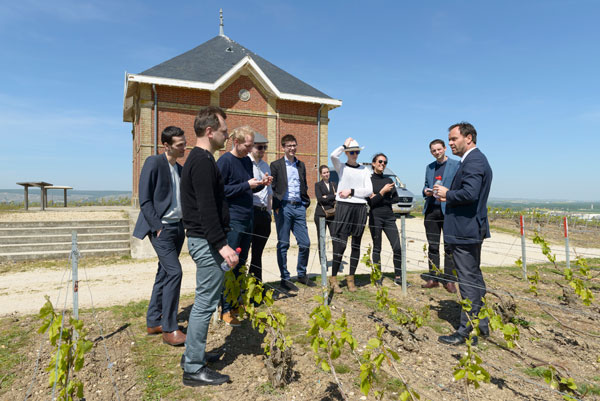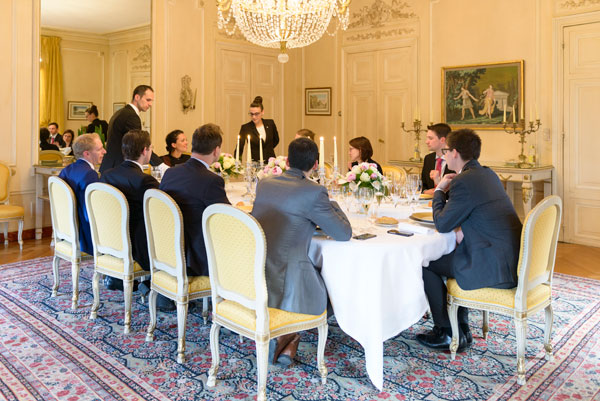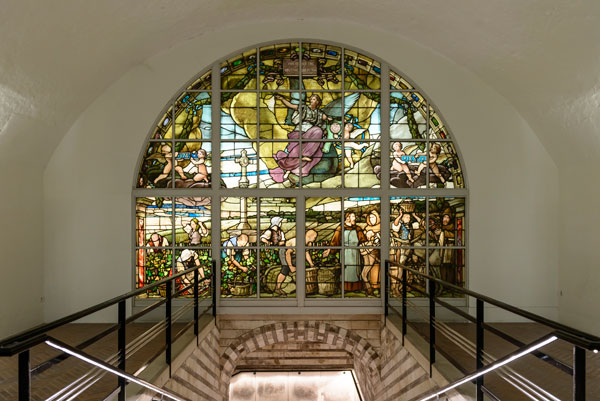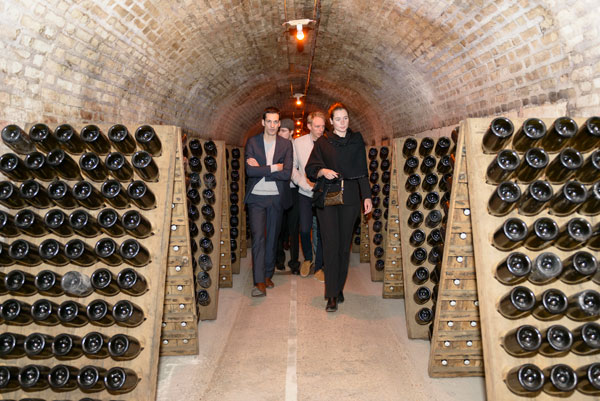UK Sommelier of the Year 2017: Finalists trip to Moët & Chandon headquarters in Épernay
Four finalists from the Moet UK Sommelier of the Year 2017 competition took a tour of the brand's vineyards and cellars, sat down to a grand vintage dinner with food chosen to match the wine, and took part in a once-in-a-lifetime tasting session. Neil Gerrard joined them
It's a beautifully sunny spring morning in Épernay in Champagne in France, but all the finalists of the Moët UK Sommelier of the Year 2017 competition want to talk about is frost.
More specifically, they are quizzing Philippe Lesne, Moët & Chandon's vineyard director, who is guiding them on a quick tour of one of the planet's most famous vineyards, about the unseasonably cold conditions that gripped Champagne in April, when temperatures fell as low as -6°C. There were fears that such icy conditions could wreak havoc on the grape harvests, and the sommeliers are anxious to know from Lesne if Moët will suffer.
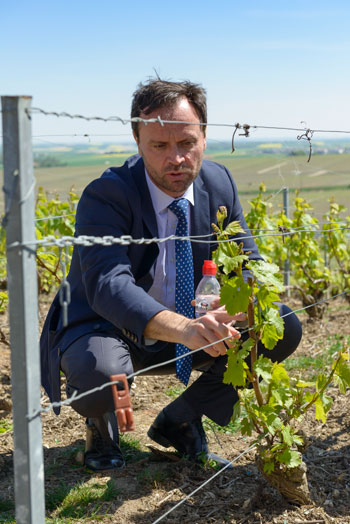
And they learn all that within the first few minutes of arriving at Ãpernay. Itâs all part of a two-day visit laid on especially for the finalists so they can experience the craft and dedication that goes into creating Champagneâs most famous brand.
Ãpernay may be smaller than nearby Reims, but it is no less important to the story of regionâs most famous export. As the groupâs minibus trundles down the Avenue Champagne on the way to Moëtâs headquarters, itâs remarked that this is the richest street in the world. Whether thatâs true or not, it wonât be as a result of the grand properties that line the road (Pol Roger and Perrier Jouet are also based here), but because of the millions of bottles of Champagne stored underneath them.
There are apparently 110km of cellars in Ãpernay, compared with 80km in Reims. Moëtâs are the oldest in Ãpernay, dating back in part to the early 18th century and holding somewhere in the region of 200 million bottles.
Moët & Chandon is, after all, responsible for 12% of all Champagne production. Itâs all about the base Once back at Moëtâs headquarters, the sommeliers got the chance to enjoy a tasting of the base wines that make up Champagne, conducted by Marie-Christine Osselin, a wine maker with the enviable responsibility for checking the quality of the wines Moët uses.
Osselin explains that such is Moëtâs size and popularity that its own vineyards cannot satisfy all of the Champagne houseâs demand. It therefore relies on 450 carefully selected suppliers with vineyards around the region.
The base wine tasting that she conducts, comparing two Meunier wines, two Pinot Noirs, two Chardonnays, the final âassemblageâ, and a glass of the finished product, the Moët Impériale, is the same she would undertake with those very suppliers. âI work with the suppliers first to explain the oenology needs in the juices, because we have a particular style in Champagne,â Osselin says. âWe always work with the fruitiness from the grapes and we are the most demanding with our suppliers when it comes to the quality of the juices. We have to explain throughout the year why Moët & Chandon is all about quality for the grapes. I need to be present during the harvest time to check the quality is right for us.â
The base wines the finalists taste are from 2016, when a cold and dry July followed a cold and grey spring. August was a little better, Osselin says, before a beautiful September that led to very healthy grapes with a good level of ripeness, particularly for the Meunier, which is the most sensitive of the varieties
Exclusive experience
Later that same day, Osselin hosted the finalists at a sumptuous dinner cooked by executive chef Marco Fadiga in the opulent surroundings of the Trianon residence, which reputedly played host to Napoleon several times.
Fadigaâs menu expertly matches up to the wines paired with each course, but it was the pairing of Moëtâs latest innovation, MCIII, with a dish of quail that really got the sommeliers excited. MCIII, an assemblage of six different Moët & Chandon vintage wines, has taken more than a decade to develop. It is a combination of wines aged in stainless steel vats and oak casks with more mature vintage Champagne aged on lees in glass bottles.
As if that were not enough, the following day the sommeliers were invited back to Moëtâs headquarters for a tour of the cellars.
They got to view not just the public cellars, which see around 100,000 visitors a year, but also the Grand Vintage Reserve cellars, to which only a special few â" the finalists of the Sommelier of the Year competition â" ever gain access.
Of course, the bottles from some vintages are more numerous than others, and if thereâs enough, the winemakers will open them. âIf we have enough volume, we continue to open the bottles from time to time to follow the evolution of the wine,â Brevot explains. âWe still have a lot of volume for the 1900 or 1921 or
1911, but when we have very few, we stop and keep the wines more for the patrimony. We donât open it and we donât sell it. We open, disgorge and taste it immediately, because the oxidative shock is very important. When you disgorge, it is a shock for the wine. A young wine will recover from the shock easily, but the older ones are like old people, who have more difficulty recovering from an operation.â
The 1921 vintage, he says, is amazing, with an unusual vibrancy and freshness. The sommeliers donât get to try a 1921 but they work their way through a 2008 vintage, a 2005, a 1996 and a 1988, several of which are expertly disgorged before their eyes. The sommeliers manage to guess the year for several with a remarkable degree of accuracy.
The last two vintages offer something of a contrast â" the penultimate being a 1978, which was an awful year for the harvest, according to Brevot, with two-thirds of it destroyed. It was a small crop, but then a very good summer led to grapes with high acidity, making them particularly suitable for a vintage. The last is something special. With notes almost of white truffle on the nose and fine bubbles, itâs a 1959, which was the ripest-ever year with exceptionally warm weather, according to Brevot. Somewhat impressively, Gareth Ferreira correctly guesses the year, having tried a vintage Champagne from 1959 before, demonstrating the level of expertise these sommeliers possess.
Among the many, many things they learn throughout the day is the fact that a tough start for the grapes, such as a frost, does not necessarily mean that a vintage wonât be produced.
To that extent then, perhaps there is still hope for 2017 after all. Only time will tell.
What the sommeliers thought
Romain Bourger
âItâs always quite fun to guess the vintage, especially with wines that have recently been disgorged, where it is a bit more difficult. Overall it was an amazing experience. We were very well looked after, and the grand vintage tasting was really unique. The dinner was a highlight because of the MCIII â" I am not sure we will have an opportunity in our life to taste that again. I thought the pairings worked very well with the complexity of the wine.â
Gareth Ferreira
âIn terms of the progression of the trip, it started in the vineyards and finished with a â59 magnum, going through base wines, and then with the grand vintage dinner last night with the MCIII, which I have never tasted before and donât really know much about, so that was a pretty unique experience. Another highlight for me was the tasting in the Grand Vintage Reserve cellars. I have never really tasted wines that have just been disgorged with zero dosage. If you have never done it before, it is a different way to taste Champagne. Highlights? Itâs difficult to pick out any particular things, but the progression of starting in the vineyard, tasting base wines and finishing with the â59 magnum was memorable. We went through the philosophy of Moët & Chandon in a day.â
Olivier Frayssinet
âIt was a very good experience. For me, the highlight was the dinner at the Trianon residence, which was fantastic. We tasted different wines with matching dishes, and the chef explained how he had changed the dishes a bit to suit the wines as well. The MCIII, which is quite rare, was very impressive. I donât think it is something that I will have the chance to try again. Itâs not just its rarity, itâs a completely different style from what we can expect from Moët, so it was a very good experience. We were with a lot of very competent people, so whenever we had a question they just answered it.â
Julia Sewell
âI have never been to Champagne before, so it was exciting just to come here. In a way, the whole thing is a highlight. We fitted a reasonable amount into just a couple of days. It is only one producer, so everything seamlessly fitted together â" see the vineyard, meet the person who controls the vineyard, taste the base wines. The pairings at the dinner were very interesting â" to be able to taste food that has been designed specifically for wine rather than the other way around. I liked the spice of the quail with the MCIII.â



